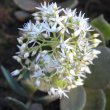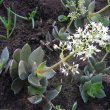| Botanical Name |
|
| Family |
Crassulaceae - The crassula family. |
| Pronunciation |
|
| Common Name(s) |
English: Knysna crassula; Taylor's Parches
|
| Plant Group |
- Succulent A plant having fleshy stems or leaves often adapted to dry conditions.
|
| Plant Size |
- Small
| Tree | 4m to 8m |
| Shrub | 50cm to 75cm |
| Perennial/ground cover | 10cm to 20cm |
| Bulb | 20cm to 30cm |
| Succulent | 10cm to 20cm |
|
| Position |
- Light or Dappled Shade Found below trees with sparse, open foliage. Ideal for the protection of herbaceous plants.
- Partial Shade The area is in shade for part of the day and in full sun for part of the day.
- Sun The area is in full sun for all or most of the day, all year round.
|
| General Information |
- Drought Tolerance: Moderate The plant is moderately adapted to arid conditions and can survive short periods of drought and high temperatures without extra water.
- Evergreen Plants that have leaves all year round.
- Frost: Half-hardy The plant is able to survive low temperatures and some frost but requires protection against severe frost.
- Water Moderate These plants will need some extra watering compared to water-wise plants. Plant them together, in at least some shade and in a convenient proximity to the house so that grey water can be utilised during times of drought.
|
| Specific Information |
Unlike most crassulas, Crassula lactea is a summer grower. It has a decumbent (or trailing) to erect growth habit. The plant branches from the base to form dense groups. A very neat plant with short broad leaves compactly arranged on short stems. The leaves are punctuated by white dots along the margins, which are a salt crust left behind at points where hydathode (?) glands secrete water. The flowers last for several weeks.
|
| Ad Break |
|
| Flowers |
| Description |
large, pyramid shaped sprays of small star-shaped flowers
|
| Season |
- Winter to Spring Plants will seldom bloom for the entire season as given in the list, but should flower during a period within these parameters.
|
| Colour |
|
| Growth Rate |
- Moderate Specifying growth rate can be very misleading as there is considerable variation of growth rate depending on type and species of plant, available water, supplementary feeding, mulching and general care, as well as the plants suitability and adaptability to the garden environment.
|
| Plant Uses |
- Attracts bees, butterflies or other insects This plant attracts insects which can be food for birds or other creatures in your garden.
- Border A strip of ground, at the edge of a driveway or path in which ornamental plants or shrubs are planted.
- Container Trees, shrubs and ornamental species that can adapt to growing in a restricted environment.
- Edging A low growing plant that provides softness or definition to the edges of a bed or walkway.
- Filler Either a fast growing tree or shrub used temporarily to fill in an area while the permanent plants grow to a desired size, or a plant used to fill gaps in borders or beds.
- Ground Cover Low-lying plants that spread fast, require minimal maintenance, and cover large expanses or bare areas between bulbs or shrubs. They provide protection from erosion and drought and improve the visual appearance of the garden.
- Mass Planting Plants useful for filling a large area with just one or a few kinds of plants spaced close together. Creates a bold, dramatic effect and to reduces maintenance.
- Rock Garden An area constructed of larger rocks, arranged naturally, to emphasise the use of stones as a main element. Generally plants used do not need a lot of care.
- Suitable for coastal gardens Plants adapted to dry, sandy soil, forceful wind, limited rainfall and intense sunlight.
- Wild Garden An indigenous garden planted for the benefit of wildlife and birds. Provides food, water, a variety of mini-biomes and no poisonous chemicals are used.
|
| Distribution and Habitat |
in the Eastern Cape, KwaZulu-Natal and Mpumalanga, in rocky terrain
|
| Planting Suggestions |
Plant in well drained soil in a partially shaded position. Add some compost if the soil is depleted.. Mulch to retain moisture. I have found that this plant does not do well in full sun, especially in summer. It must however have some direct sun daily or it will not flower successfully. It flowered best for me under 30% shade netting but deteriorated alarmingly in full sun in the garden. It propagates easily from stem cuttings. Cut the upper growth off to make new plants. This also encourages bushier growth on the parent plants. Keep the plants reasonably well watered during the summer growing period but they can be left drier during the winter months. (Conversely, it has been reported as suffering no damage in winter rainfall areas.)
|
| Medicinal Uses |
|
| Ad Break |
|







Discuss this plant
Share knowledge, ask a question or give an experience.